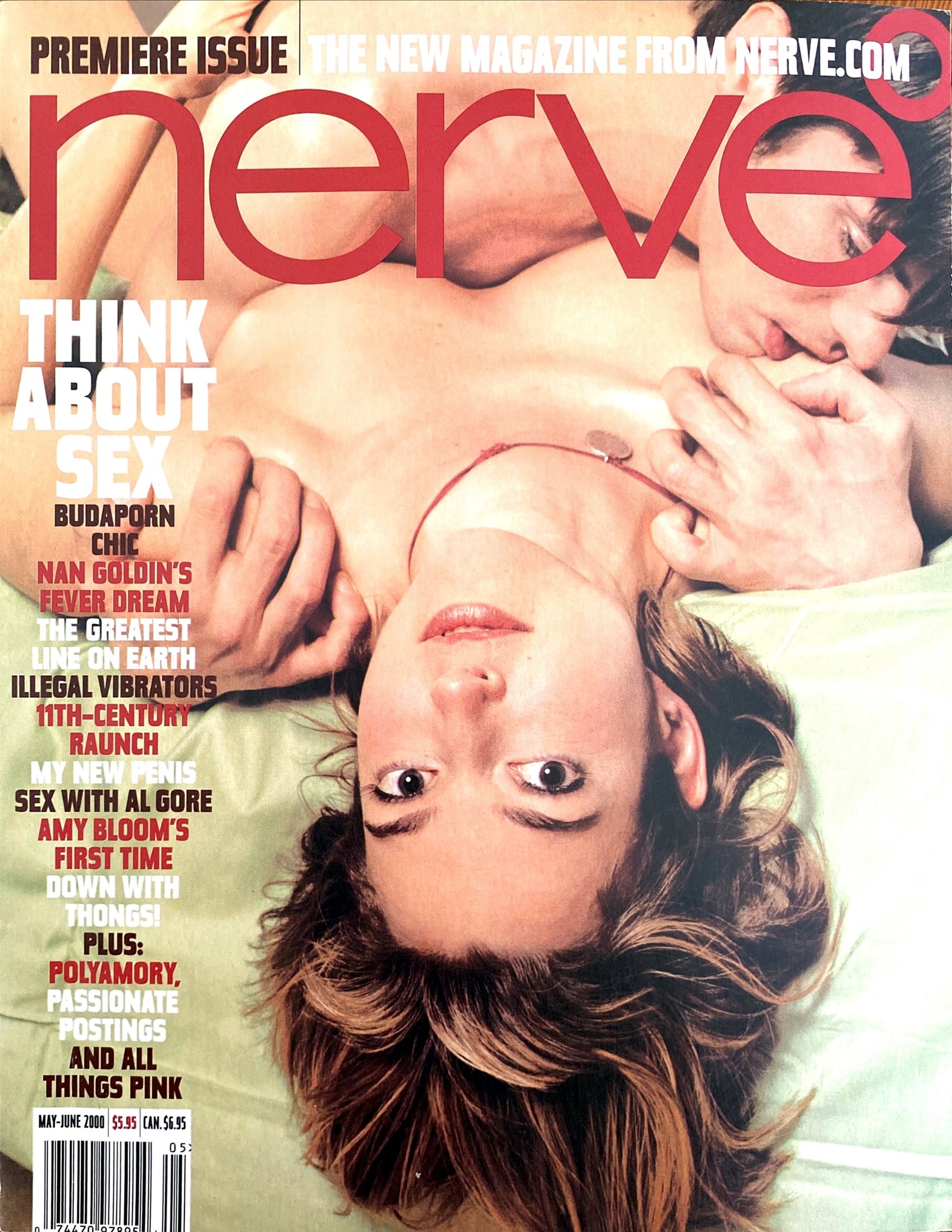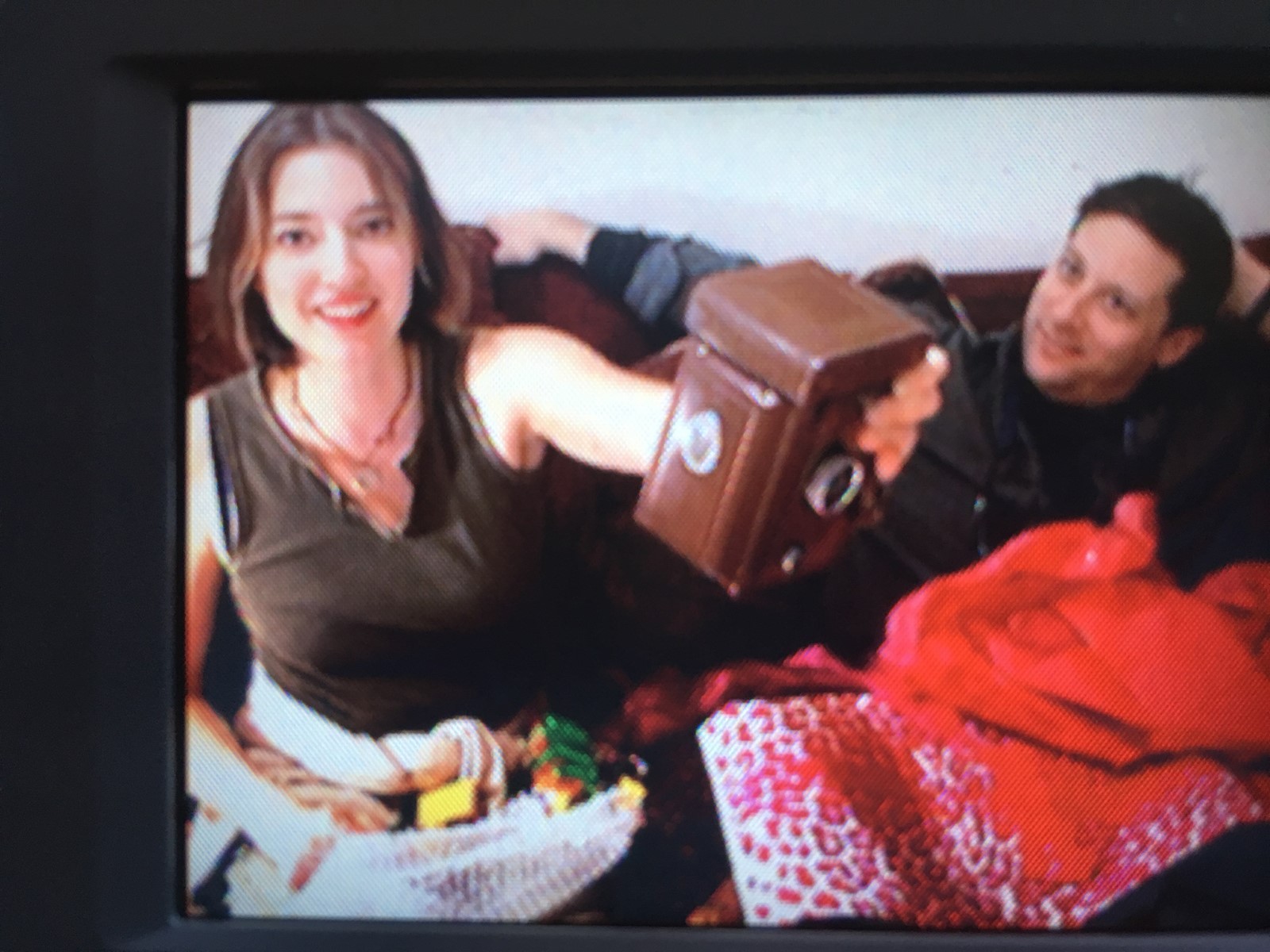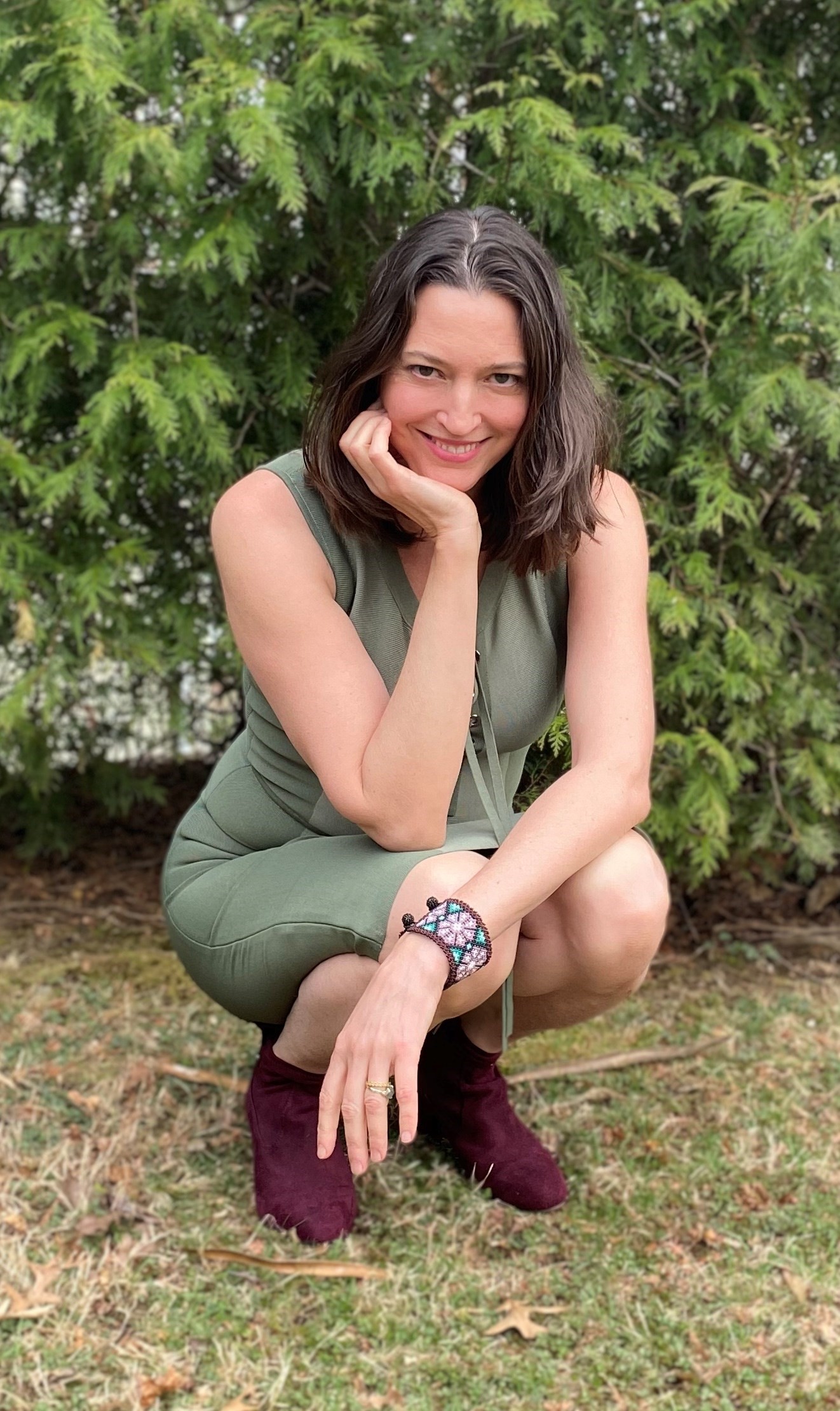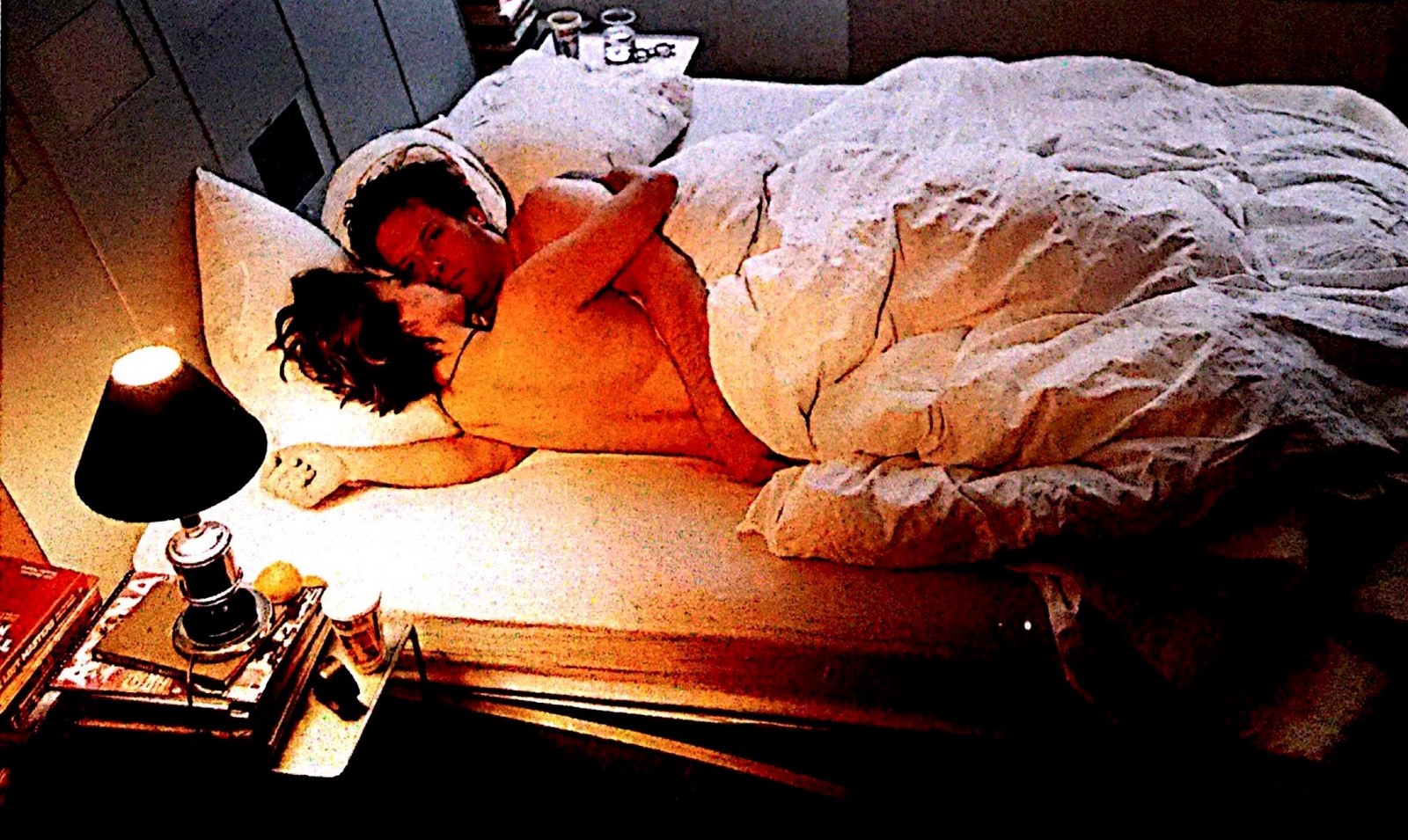Sex, showering, breaking up: Tanya Corrin and her boyfriend Josh Harris set up cameras all over their apartment for an internet project that pre-empted everything from influencer culture to digital sex work and reality TV
In our Under the Influence series, we trace the ideas of underground artists, designers, labels, and collectives, and the impact that they’ve had on pop culture as we know it, examining how the revolutionary aesthetics and attitudes of outsiders make their way into the mainstream, and importantly, how much that should be valued and not forgotten.
On a cold and dark New York evening in February 2001, Tanya Corrin is breaking up with her boyfriend. Of the many break-ups happening in that very second across the world, this one is different – thousands of people tune in to watch. Playing out on a grainy black and white screen, the break-up ensues, Corrin picks up her bag, and leaves her apartment for good.
This melancholic scene isn’t a TV drama, but a live computer stream that captured the couple’s lives, transmitted to a quarter of a million viewers via 32 cameras and 76 microphones set up around their home. Speaking over the phone 19 years after the break-up, Corrin declares: “No one had done what we did”. And she’s right.
Corrin’s boyfriend was internet entrepreneur Josh Harris, who founded one of the first ever webcasting sites, Pseudo.com, in 1993, and led the 1999 Orwellian concept, Quiet: We Live In Public, in which over 100 volunteers lived in an NYC loft with surveillance cameras capturing their every move. It was the latter that inspired Corrin and Harris’ collaborative project, We Live in Public, in which the pair would eventually end their relationship. It’s a moment central to the Museum of Sex’s exhibition Cam Life – currently postponed due to coronavirus – which delves into the untold history of cam and web chat, virtual intimacy, and sexual desire in the age of the internet.
“Josh and I agreed that we were going to live in public for 100 days,” Corrin explains. “We were allowed to come and go, but when we were at home, the cameras would be on.” These ever-rolling cameras were placed all over the couple’s apartment, from the bedroom to the inside of the toilet bowl.
Corrin is regarded as one of the pioneers of webcam culture, and therefore one of the first ever cam girls, along with Jennifer Ringley, who created what we now call life-casting in 1996, and Ana Voog, who gave birth on webcam in the late 90s. “Camming opened up a space for both women and LGBTQ+ gender non-conforming people to take over control of their own image,” says Cam Life’s co-curator, Lissa Rivera.
As the internet developed throughout the 90s and early 00s, chat rooms and webcams fostered a sense of community and self-expression, and created the first wave of internet stars. Unlike the influencers of today, early cam girls were less able to curate their image, instead presenting much more uncensored lives and selves. “Early camming was more like surveillance,” explains Rivera. “You couldn’t get away from the camera – it had more power than you did. Now, everything’s more fake-real; it’s manipulated and edited, and everyone can create their own narrative.”
In the millenium before her face was a frontpage feature on the internet, Corrin was living in her small Maine hometown – she describes it as “pretty backwards”, and dominated by three local TV channels. Despite this, the now-51-year-old always “had a hunger for TV” and “to see how other people lived”. After graduating from a local college with a degree in economics, and bouncing between jobs for a while, Corrin moved to New York in 1995, where she later met Harris and began her journey to internet-stardom. “We met at an art party,” Corrin tells me, “and at the time, I had never logged onto the internet. Most people actually hadn’t, because the internet was only invented in the year that I graduated from college. When I met Josh, he started talking about his company, Pseudo.com, and this internet radio show, which completely blew my mind. Like, what? Radio on your computer? I thought it was crazy at first.”

Corrin was inspired by his passion, explaining that she “had to find out if what everybody was talking about was real”. She logged onto the internet the very next day. “It was a really different experience than it is now. My boyfriend had to help me, and it was really slow, but it did blow my mind and I felt like I wanted to be a part of it.” Corrin immediately headed to the bookstore and bought a book which promised to teach coding in 14 days. “I taught myself HTML, then over the course of the next year, I started programming web pages.”
Corrin quickly became involved with Pseudo. Comparable to today’s YouTube, Pseudo was an online television network that offered viewers a number of livestreamed and pre-recorded shows. Corrin soon launched her own show on the platform, Tanya TV, where episodes traced stories of “real New Yorkers”, who were “facing their sexual insecurities”.
“I always had this struggle with sexuality because it was so repressed,” Corin explains. “The only sex education I got was in sixth grade from the principle of the school, and I ended up being so confused about sex. It was when I was 25 that I thought I’d invented masturbation (laughs) – I was like, ‘Oh my god, I can’t believe I’ve found out and no one knows about it’. I was incredibly sexually inhibited, but felt like the internet was an opportunity to become who I was. I had a lot of questions about sex, and I kind of just tried to answer them on my show.”
“I was incredibly sexually inhibited, but felt like the internet was an opportunity to become who I was” – Tanya Corrin
Now regarded as a form of sex work, camming in the 90s and early 00s began with a sexual element; Ringley and Voog both engaged in sex and masturbation during their webcam streams. Corrin was particularly fascinated with the topic of sex, partly spurred on by a new TV series called Sex and the City. She began a Pseudo show called Sex on the Sidewalk, where she would ask New Yorkers the “sex question of the day”, and she appeared naked on the cover of Nerve in summer 2000; and, in a November 2000 interview with WIRED, she alluded that she would masturbate on camera during We Live in Public, while Harris asserted that the pair would conceive their first child on camera. However, when faced with the reality of having sex on webcam, Corrin couldn’t do it.
“One of the things I knew from Tanya TV was that sex sells,” explains Corrin, “so when I was telling Charles Platt (journalist for WIRED) that I would masturbate in public, I really believed I could do it.” We Live in Public was uncensored, 24/7 – unlike Tanya TV, where Corrin could edit out anything she didn’t want the public to see. It marked a seismic shift. “I had this illusion that I could just not say things and not do things, and that would be how I would edit. But very quickly you had people who were excited to see a child get conceived, or see me lying down on the bed masturbating, and suddenly I wasn’t in the mood.”
Viewers could watch Corrin and Harris for free at any time, and were able to comment in real time on the site’s chat room. The couple could also see and respond to commenters. Disappointed that Harris’ promise of sex wasn’t materialising online, viewers became hostile and aggressive, particularly towards Corrin. “I might have been one of the first people to ever get flamed in all caps,” Corrin tells me. “They’d say: ‘Take your shirt off, your boyfriend’s horny. Go fuck him, this is so boring’. Over the course of the first week, I learned to start ignoring the negative comments… although I didn’t do it very well because they could always get me. I’d wind up screaming at the computer, like: ‘You go take your shirt off! Why don’t you have sex with your wife right now?’” Harris never faced the same levels of sexualised abuse as Corrin.

For the first time, viewers could get a peep show experience from the comfort of their own homes, newly fulfilling both their voyeuristic and sexual desires. Though We Live in Public was free – and not a sex show – webcam stars did soon begin to charge viewers for the luxury of watching them. At a time when the porn industry’s revenues were declining due to piracy, camming enabled sex workers to generate independent income, and gave amateurs the opportunity to earn extra cash. “It was a time when women’s voices and their narratives were in a very outdated lens,” says Rivera. “It’s interesting to reassess what Tanya did, versus how she was treated.”
Despite the abuse – which Corrin later combatted by giving trusted watchers moderator capabilities – Corrin says she relished the wider attention. “I would get up and open the refrigerator door and feel really excited because I knew there was a camera in there,” she explains. Unlike modern camming, which one cam girl told Dazed requires “having a kind of alter-ego”, Corrin believed she would be able to be 100 per cent herself, even with the cameras constantly rolling. The reality was a little different. “I’d make sure that if I had to burp, I wouldn’t, because I wanted to present myself well,” she continues. “I suppose I didn’t think of it as acting, but simply improving. People would ask me about ‘that reality show’ – they thought it was a show, but I thought I was being myself.” But Corrin did breathe a sigh of relief every time she left the surveillance of the apartment. “Even though I was on a busy street in New York City, with thousands of people passing me by, I felt alone. I felt like people weren’t watching me.”

Corrin ended up partaking in We Live in Public for 78 out of the 100 planned days, leaving weeks before Harris decided to tap out. “We were both overwhelmed,” says Corrin. “Josh did not realise the impact it would have on his personal psyche and mental health. With Quiet, he was in control, and it wasn’t public. But we responded to it differently – I wanted to have conversations and connect, but he shut down and didn’t want to talk. He had a big problem because he wanted to be the centre of attention, but I wasn’t really helping him look good – he would kiss me and I’d freeze. That didn’t really look great, you know, when 200 people are watching you and your girlfriend isn’t responding to your sexual advances.”
While traditionally viewed as Harris’ project, Corrin was arguably the person who not only drew the audience – as she says, sex sells – but actually kept them around. When the couple began having problems within their relationship, viewers started to take sides. In a 2001 article for the New York Observer, Corrin notes the hundreds of fan letters she received, and how she made sure to answer them all. Josh, who was too busy to reply, was soon getting just three or four a day. “The chat room became more hospitable,” Corrin explains. “I started connecting with people who were like, ‘It must be so hard what you’re doing’, and, ‘I heard Josh say this to you, how did that feel?’” By the end, Corrin formed such a bond with the audience that when she left the apartment, she says it felt like she was breaking up with them as well as Harris. “My relationship with Josh got so bad. I knew I needed to leave, but I didn’t want to leave the watchers. So many of these people actually cared about me, and were trying to help me out of a bad situation even though it meant I would ultimately abandon them. I had to leave them forever.”
“I knew I needed to leave, but I didn’t want to leave the watchers. They cared about me, and were trying to help me out of a bad situation even though it meant I would ultimately abandon them. I had to leave them forever” – Tanya Corrin
The so-called ‘dot-com bubble’ burst shortly before the pair began We Live in Public. A number of internet pioneers lost all of their money, as business ventures and capital investment waned. “Investors didn’t understand the technology of the internet, so were throwing money at young people in programming,” explains Rivera. “They were given unlimited funds – billions of dollars – to build these experimental infrastructures, but when other corporations took hold of larger corporations, it became less in the hands of the people. The bubble burst, and the young entrepreneurs weren’t getting the money anymore.” Pseudo tanked, Corrin lost her shows, and the money Harris had made from his first company, Jupiter Communications, disappeared. The entrepreneur had put over $1 million into We Live in Public, and eventually had to end the project due to financial losses (as well as mental strain).
“After we broke up, I initially didn’t watch it at all,” Corrin recalls, “but then I wrote an article for the New York Observer, so I logged on once and saw him. I felt so bad for him – he was like a shell of himself.”
Corrin abandoned the internet quickly after exiting the apartment for the final time. Instead, she worked on carving out a career as a freelance journalist. By the time social media as we know it today began to blossom and emerge, Corrin had no interest in being online. “One thing that I am absolutely adamant about now is the importance of protecting our privacy,” she tells me. “Without privacy, we can’t be who we are – it’s fundamental to our integrity. For a long time, I thought I had made the biggest mistake, but now when I think about the heavy load I carried, I don’t regret it at all. It totally sucked, but I got to learn so much. I feel like I’ve grown in ways I never would have been able to if I hadn’t gone through that.”

We Live in Public was instrumental in the emergence of camming, and predicted a future both of online sex and constant surveillance – in public and through social media. “They were in this isolated space that no one was occupying,” says Rivera, “and now the world is caught up and (surveillance) has become so normal. People feel guilty if they don’t share everything – now, it’s a choice not to, instead of a choice to. There’s this feeling that if you’re not doing Instagram Stories, then you’re not participating in the culture and you’re somewhat invisible.” As Harris once said: “One day, we’re all going to wake up and realise that we’re just servants. (The internet has) captured us.”
The late 90s fascination with ‘ordinary’ people stemmed not only from the emergence of a more global world, but from an obsession with watching others just like us. “It’s the closest we can get to seeing ourselves,” muses Corrin. “Everybody wants to be seen. It’s a fundamental aspect of ourselves.” We now live under total surveillance, but our appetite for a window into other people’s worlds hasn’t dwindled. Reality TV is more popular than ever, and social media has transformed both what we share and the way we share it – from personal brands and influencer-on-influencer beef, to curated Instagram aesthetics and TikTok houses full of teen creators. Though it has the ability to pull us apart ideologically, the internet has an inimitable ability to build community – something that’s been particularly powerful during the current coronavirus crisis. We Live in Public was one of the first experiences to prove this. “It wasn’t just Josh and I that went through this thing together,” Corrin concludes. “It was also the few thousand people who were watching us. They were part of something new, too.”

